March 10, 2020 feature
Electrical power generation from moderate-temperature radiative thermal sources

Thamarasee Jeewandara
contributing writer
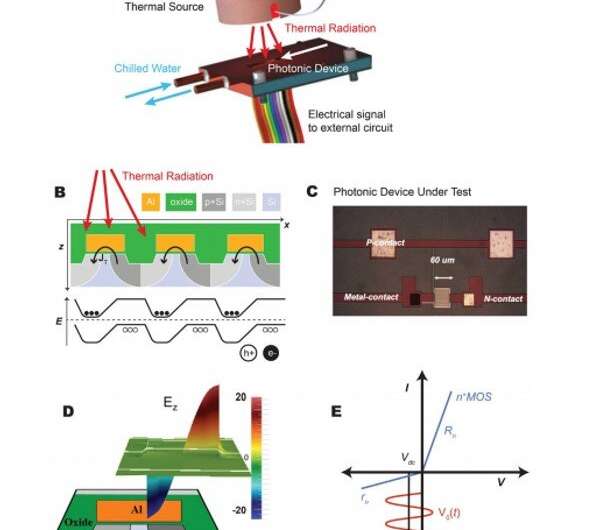
Moderate-temperature thermal sources often radiate waste heat as a by-product of mechanical work, chemical or nuclear reactions, or information processing. In a new report in Science, Paul S. Davids and a research team at the Sandia National Laboratory in the U.S., demonstrated the conversion of thermal radiation into electrical power. For this, they used a bipolar grating-coupled (CMOS) . Using a two-step photon-assisted tunneling charge pumping mechanism, the team separated the charge carriers in wells to develop a large, open-circuit voltage across a load. The scientists experimentally showed electrical power generation from a broadband blackbody thermal source with converted power densities of 27 to 61 µW/cm2 for thermal sources between 250 degrees C to 400 degrees C. The demonstrated scalable and efficient conversion of radiated waste heat into electrical power can be used to reduce energy consumption—in order to power electronics and sensors.
At finite temperature—all objects radiate due to thermal fluctuations of their atomic constituents in a characteristic spectrum that depends on the surface temperature and spectral emissivity of the object. The sun's radiative heat transfer is the dominant radiative energy resource currently available to Earth and is an effective and rapidly growing technique aiming to convert this incident radiation to electrical power (e.g. solar cells). However, other sources of radiative heat including cooler terrestrial sources or man-made waste heat can give rise to considerable net energy exchange as a readily available electrical power source, provided efficient conversion.
New approaches for energy conversion and photon-mediated charge pumping.
Thermophotovoltaic (TPV) devices that convert radiation from broadband thermal sources into electrical power are promising technologies to convert solar energy and for waste heat recovery. Such devices generally work by heating a secondary thermal source as a selective emitter, where an emission spectrum is filtered and matched to a small bandgap semiconductor device. The semiconductor device can be pn junction designed for absorption of a photon to take place in its depletion region creating an electron hole pair and result in the separation of charge and the induction of an open-circuit voltage across the device. However, TPV conversion from a moderate temperature source for large-scale power generation can be very challenging. Scientists have therefore proposed for improved TPV conversion efficiency from moderate temperature sources.
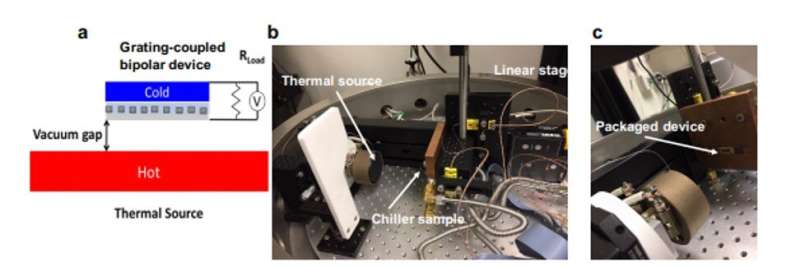
For example, for thermal to electrical conversion were based on (converting alternative current to direct current) of infrared radiation using . Davids et al. suggested a new means for thermal photovoltaic conversion from a low-grade thermal source in the temperature range of 100 degrees C to 400 degrees C via photon-assisted tunneling and a spatially-varying confined optical field in the tunnel barrier. An interdigitated bipolar pn junction array under the tunneling gate electrode acted as a charge pump to move electrons from the p-type region to the n-type region within the optical field. The scientists optimized the setup and contacted the interdigitated p and n regions separately to measure power generation across a variable external load resistance, R—which shorts the pn junction. The effective diode voltage multiplier circuits resulted in orders of magnitude improvement in electrical power generation compared to direct rectification.
Modelling the device.
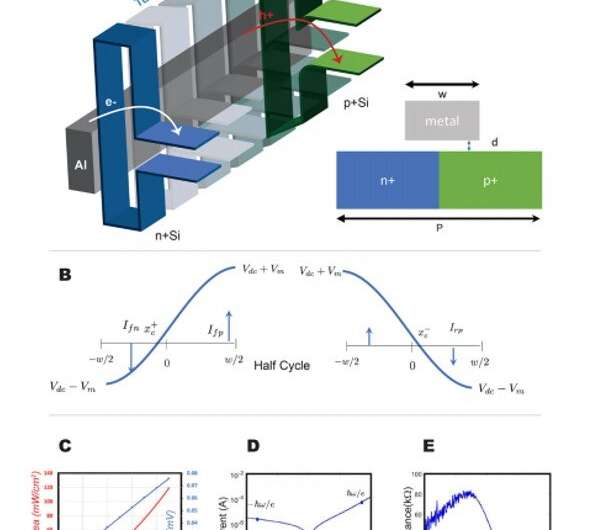
An ideal device model for thermal photovoltaic conversion in a bipolar antenna-coupled tunnel diode rectifier generally contains a buried symmetric pn junction, under an equilibrium MOS (metal-oxide-silicon) metal gate. The device can be illuminated by a thermal source modelled as a blackbody broadband emitter. Davids et al. observed a complex current due to the complex admittance (current flow) of the tunnel diode, based on its conductance and capacitance. The self-consistent dc voltage could be estimated by the , which required the half-cycle currents generated in the device to be equal and in opposite directions. As a key feature of the bipolar conversion device, the team noted a periodic buried pn junction under the metal, for charge storage, pumped by the combined action of the two forward biased tunnel junctions. They noted that larger the open circuit voltage, greater the power generation in the bipolar device.
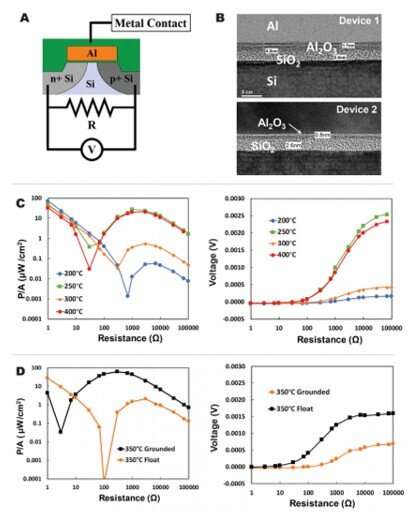
Experimental results
The scientists measured electrical power generation from a moderate temperature source using a vacuum TPV setup, with an approximate 2-mm scale gap between the . The device contained three-terminals with interdigitated n and p regions with separate n, p and metal contacts. They measured the induced voltage from the thermal source at fixed temperature by shorting the pn junctions with a variable load resistor. They followed this with measurements of the induced voltage as a function of the load resistance with a nanovoltmeter. The process and device parameters played an integral role during the performance of the bipolar device.
The oxide thickness and composition of the device also affected the tunneling resistance and dispersion field concentration. In addition, the implant conditions and thermal annealing cycles greatly affected the pn junction characteristics under the metal gate. Davids et al. confirmed the features of the fabricated devices using two (TEM) cross-sectional images, of two different devices (device 1 and device 2) – taken beneath the gate metal.
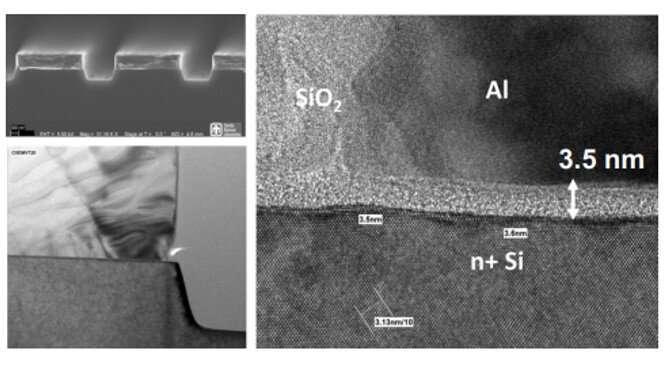
Davids et al. confirmed alumina makeup of the devices using (EDS). The impact of the thick alumina layer shifted the peak power density to lower source temperatures, since resonances occurred approximately at 200 degrees C. The work showed a complex interaction of the gate oxide longitudinal phonon mode and device design parameters that determined the output power for this new form of photovoltaic conversion. This allowed Davids et al. to adjust the operational temperature of the device by tuning the longitudinal phonon resonance. The bipolar devices far exceeded the limit of direct rectification (ac to dc conversion), suggesting that photon-assisted tunneling and charge separation could be further improved through device and process optimization.
In this way, Paul S. Davids and colleagues demonstrated efficient conversion of moderate-temperature radiative thermal sources as a largely untapped resource for energy harvesting. They built radiative thermal to electrical energy conversion on a bipolar grating-coupled tunneling device as a scalable, compact energy harvesting technology. The devices can be used as a stand-alone energy converter or in conjunction with thermoelectric power generators. The method relies on n- and p-type wells in a bipolar grating-coupled device. The results showed an electrical power density of 61 µW/cm2 from a 350 degrees C thermal source for an estimated conversion efficiency approaching the efficiency of TPV conversion—but with significantly cooler source temperatures. Davids et al. will optimize the device architecture and its process for improved power generation.
Written for you by our author —this article is the result of careful human work. We rely on readers like you to keep independent science journalism alive. If this reporting matters to you, please consider a (especially monthly). You'll get an ad-free account as a thank-you.
More information: Paul S. Davids et al. Electrical power generation from moderate-temperature radiative thermal sources, Science (2020).
W. R. Chan et al. Toward high-energy-density, high-efficiency, and moderate-temperature chip-scale thermophotovoltaics, Proceedings of the National Academy of Sciences (2013).
Anthony Fiorino et al. Nanogap near-field thermophotovoltaics, Nature Nanotechnology (2018).
Journal information: Science , Proceedings of the National Academy of Sciences , Nature Nanotechnology
© 2020 Science X Network

















